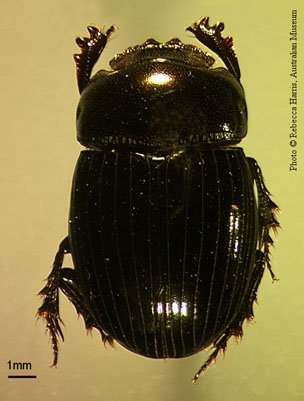![]()
![]()
![]()
Genus Thyregis

Species found in eastern New South Wales: T. kershawi, T. monteithi, T. relictus.
Other species: T. tarsatus (WA)
Distribution
South-western and south-eastern Australia.
Description
Medium to large (8-12mm long), oblong, strongly convex. Smooth, largely hairless. Dark brown to black in colour, antennal clubs yellow. No dorsal keels or tubercles on pronotum or elytra.
Two small clypeal teeth; frontoclypeal area elevated into low transverse ridge or short horn in male. Pronotum strongly convex, lateral margins partly hidden from above. Anterior part of underside of pronotum not strongly excavated, with a complete oblique keel joining coxal cavities and lateral margins, and a longitudinal keel running halfway forward from posterior edge, parallel to lateral edge.
Elytra: elytra with 10 complete striae, including one along epipleural edge; striae 1-9 with distinct punctures. No pseudepipleura.
Hind wings: Fully developed or reduced.
Legs: Outer edge of fore tibiae with 3 large teeth. Anterior metasternal intercoxal process longer than broad. Middle coxaelongitudinally aligned and parallel. Middle and hind tibiae strongly expanded distally, with a transverse keel on outer face. Two strong spurs of unequal length on middle tibiae and one on hind tibiae. Claws slender, curved, simple.
Abdomen: Last sternite as long or longer medially than previous 4 sternites combined. Pygidium transverse, strongly margined throughout, without tubercles or depressions.
Sexual dimorphism
Female clypeus slightly more strongly toothed; males of T. relictus and T. monteithi with head armament.
Similar Genera
Diorygopyx, of a similar size and general shape (some species), black and shiny, two small clypeal teeth.
Obvious differences: Diorygopyx has convergent middle coxae, no head armament in any species, 9 elytral striae, sharply keeled pseudepipleuron in basal half of elytra, small teeth on outer edge of fore tibiae, no teeth on mid and hind tibiae, and strongly toothed claws.
Onthophagus, of a similar size and general shape (some species), black and shiny, middle coxae parallel.
Obvious differences: Onthophagus has no clypeal teeth, outer edge of fore tibiae with 4 teeth.
Ecology
Coprophagous, both flightless and winged species, closed forest and tall open forest.
References
Cassis, G. & Weir, T.A. (1992) Scarabaeinae. pp 106-173. In: Houston, W.W.K. (ed.) Zoological Catalogue of Australia. Coleoptera: Scarabaeoidea. Canberra: AGPS Vol. 9.
Matthews, E.G. (1976) A revision of the Scarabaeine dung beetles of Australia. III. Tribe Coprini. Aust. J. Zool. Suppl. Ser. 38: 1-52
